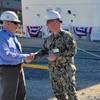Step forward the Titan Submarine, a proposal that NASA has just awarded a second round of funding through their Innovative Advanced Concepts (NIAC) program. It is very much just a concept at the moment, but it is promising nonetheless.
Aside from Earth, Titan is the only place in the solar system that has bodies of liquid on its surface, making it a rather attractive place to explore. But while a number of proposals have been put forward to take a closer look, none have come to fruition.
Phase II of the Titan Submarine: Exploring the Kraken Mare effort will focus on advancing the Technology Readiness Level (TRL) of the concept by (1) retiring risks found in the Phase I design, (2) gathering new Kraken Sea observations by Cassini, and (3) further defining science goals and instruments to fulfill them; each of these tasks will feed into two COMPASS design sessions. All of these products should ready the Titan Submarine (Titan Sub) concept to a confidence level that allows further NASA investment.
Titan is unique in the outer solar system in that it is the only one of the bodies outside the Earth with liquid lakes and seas on its surface. The Titanian seas, however, are not composed of water, like Earth’s seas, but are seas of liquid hydrocarbons.
"What lies beneath the surface of Titan’s seas? We propose to develop a conceptual design of a submersible autonomous vehicle (submarine) to explore extraterrestrial seas. Specifically, to send a submarine to Titan’s largest northern sea, Kraken Mare," says a statement from NASA.
This craft will autonomously carry out detailed scientific investigations under the surface of Kraken Mare, providing unprecedented knowledge of an extraterrestrial sea and expanding NASA’s existing capabilities in planetary exploration to include in situ nautical operations. Sprawling over some 1000 km, with depths estimated at 300 m, Kraken Mare is comparable in size to the Great Lakes and represents an opportunity for an unprecedented planetary exploration mission.
The major risks found in the Phase I conceptual design center around vehicle operations in a liquid hydrocarbon sea. Basic physics questions of operating in this cryogen need to be answered. Cryogenic experts at the NASA Glenn Research Center will develop models to explore mixtures and pressures of cryogens and gases and how they would react with a warm submarine.












